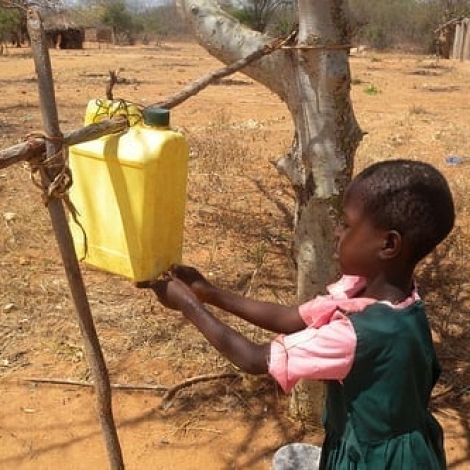
A Tippy Tap hand-washing station like this one may prevent the spread of the two leading killers of young children: diarrhea and pneumonia. Photo by waterdotorg / Flickr
Public health officials may be able to reduce the two leading causes of death in children under the age of five with one sanitation campaign. Children who suffer from diarrhea may have a higher risk for contracting pneumonia up to four weeks after their illness, according to new research.
“In light of our finding, preventive interventions targeting diarrhea might have higher importance than measured by their effectiveness in reducing diarrhea, because they could have a multiplier effect in reducing other diseases like pneumonia, the biggest cause of mortality in small children,” Sania Ashraf, a researcher at the International Centre for Diarrhoeal Disease Research in Dhaka, Bangladesh, and a doctoral candidate at Johns Hopkins University in Balitmore, Maryland, USA, told E4C by email.
“Our results imply that efforts such low cost interventions in water, sanitation and hygiene that primarily target diarrhea could highlight the impact it has on reducing incidence of other infections, specially respiratory illnesses. Simple interventions such as hand washing has shown significant impacts on both. Impact of clean water and sanitation technologies would be multifaceted as we make progress towards understanding complex interactions between diarrhea, pneumonia and malnutrition in children in the developing world,” Ashraf says.
Ashraf and her team published their results online Feb. 1st in the International Journal of Epidemiology.
Diarrhea is the second-leading killer of children under the age of five, taking more than 660,000 livesevery year, according to the World Health Organization. It is exceeded only by pneumonia, which takes1.2 million young lives every year.
Ashraf’s study included 873 households with young children in Karachi, Pakistan. There were 553 children who took part in a campaign to use antibacterial soap, 556 encouraged to use regular soap and 525 who were not a part of any soap-awareness campaign and left alone as a control group.
For two to four weeks after having diarrhea, children were more likely to contract pneumonia, at a hazard ratio of 1.06 (95 percent confidence interval: 1.03–1.09). Up to six percent of the cases of pneumonia may have been avoided by preventing diarrhea, the researchers found.
Public health workers should target diarrhea to help root out pneumonia, the researchers conclude. Both diseases are high priorities for meeting the Millennium Development Goal Four: Reduce Child Mortality.
Ashraf and her team offer a few suggestions. Treating acute diarrhea with zinc can reduce the severity of the disease and it also reduces the risk of contracting other infections, including pneumonia. And public education campaigns could warn parents and other caretakers to look for signs of pneumonia, especially following bouts of diarrhea.
The full text of the study is available free of charge: Effect of recent diarrhoeal episodes on risk of pneumonia in children under the age of 5 years in Karachi, Pakistan.
Related resources
How playing games can reduce malaria
A deadly disease is no match for online puzzle addicts.
Ten technologies for rural water supplies
Chlorinators, cisterns, sand dams, pumps and more… this is the information you need to make a clean water supply.
From the Solutions Library
Rural health care delivery using telemedicine

